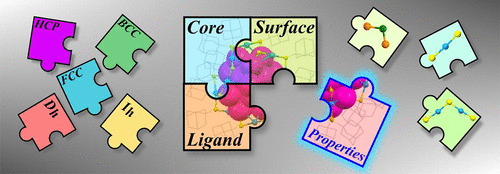当前位置:
X-MOL 学术
›
Acc. Chem. Res.
›
论文详情
Our official English website, www.x-mol.net, welcomes your feedback! (Note: you will need to create a separate account there.)
Toward the Tailoring Chemistry of Metal Nanoclusters for Enhancing Functionalities
Accounts of Chemical Research ( IF 18.3 ) Pub Date : 2018-10-29 00:00:00 , DOI: 10.1021/acs.accounts.8b00383 Tatsuya Higaki 1 , Qi Li 1 , Meng Zhou 1 , Shuo Zhao 1 , Yingwei Li 1 , Site Li 1 , Rongchao Jin 1
Accounts of Chemical Research ( IF 18.3 ) Pub Date : 2018-10-29 00:00:00 , DOI: 10.1021/acs.accounts.8b00383 Tatsuya Higaki 1 , Qi Li 1 , Meng Zhou 1 , Shuo Zhao 1 , Yingwei Li 1 , Site Li 1 , Rongchao Jin 1
Affiliation

|
Ultrasmall metal nanoparticles (often called nanoclusters) possess unique geometrical structures and novel functionalities that are not accessible in conventional nanoparticles. Recent progress in their synthesis and structural determination by X-ray crystallography has led to deep understanding of the structural evolution, structure–property correlation, and growth modes, such as the layer-by-layer growth in face-centered cubic (fcc)-type nanoclusters, linear assembly of vertex-shared icosahedral units, and other unique modes. The enriched knowledge on the correlation between the structure and the properties has rendered metal nanoclusters a new class of functional nanomaterials. Despite the significant achievements in structural determinations, mapping out the structure–property correlation is still very challenging because of the core–shell structures of nanoclusters (e.g., Aun(SR)m protected by thiolate ligands) with metal atoms partitioned between the core and the shell. In such structures, the core and the surface are entangled and cannot be separately studied because changing the core structure would inevitably change the surface (or vice versa). Thus, it is of great importance to develop the “tailoring” chemistry for structural modification of the core (or surface) while retaining the other parts, in order to achieve fundamental understanding of what part of the nanocluster structure plays what role in the functionalities. In this Account, we summarize some recent work on the strategies to control the atomic structures of metal nanoclusters for tuning their properties, such as stability, optical absorption, excited-state electron dynamics, and photoluminescence, as well as their catalytic reactivity. The development of a ligand-based strategy has permitted the synthesis of structural isomers of nanoclusters with the same size but different functionalities. Successful modification of the core (or surface) structure while maintaining the other components has led us to gain some fundamental understanding of the respective roles of the core and the surface in the nanocluster functionalities. Such “tailoring” chemistry on metal nanoclusters can provide a strong basis for functional nanomaterials consisting of nanocluster components with desired properties. Further development of the tailoring chemistry will guide materials chemists to new directions and tailor-made functional nanomaterials for specific applications.
中文翻译:

致力于增强功能的金属纳米簇的定制化学
超小金属纳米颗粒(通常称为纳米团簇)具有独特的几何结构和新颖的功能,而这些功能是常规纳米颗粒无法企及的。X射线晶体学在合成和结构确定方面的最新进展已导致人们对结构演变,结构与特性的相关性以及生长方式(例如面心立方(fcc)的逐层生长)有了更深入的了解。类型的纳米团簇,顶点共享的二十面体单元的线性组装以及其他独特的模式。关于结构和性能之间的相关性的丰富知识使金属纳米团簇成为一类新的功能纳米材料。尽管在结构性决定方面取得了重大成就,n(SR)米由硫醇盐配体保护),金属原子在核和壳之间分配。在这样的结构中,核心和表面纠缠在一起,因此无法单独研究,因为更改核心结构将不可避免地更改表面(反之亦然)。因此,在保留其他部分的同时,开发用于核心(或表面)结构改性的“定制”化学,对于基本了解纳米簇结构的哪些部分在功能中起什么作用至关重要。在此报告中,我们总结了有关控制金属纳米团簇的原子结构以调整其特性(例如稳定性,光学吸收,激发态电子动力学和光致发光以及它们的催化反应性)的策略的最新工作。基于配体的策略的发展已允许合成具有相同尺寸但功能不同的纳米团簇的结构异构体。成功地修饰核(或表面)结构,同时保留其他组件,已使我们获得了对核和表面在纳米团簇功能中的各自作用的一些基本了解。金属纳米团簇上的这种“量身定制”化学性质可以为包含具有所需性能的纳米团簇组分组成的功能纳米材料提供强大的基础。定制化学的进一步发展将引导材料化学家们朝着新的方向发展,并为特定的应用量身定制功能纳米材料。
更新日期:2018-10-29
中文翻译:

致力于增强功能的金属纳米簇的定制化学
超小金属纳米颗粒(通常称为纳米团簇)具有独特的几何结构和新颖的功能,而这些功能是常规纳米颗粒无法企及的。X射线晶体学在合成和结构确定方面的最新进展已导致人们对结构演变,结构与特性的相关性以及生长方式(例如面心立方(fcc)的逐层生长)有了更深入的了解。类型的纳米团簇,顶点共享的二十面体单元的线性组装以及其他独特的模式。关于结构和性能之间的相关性的丰富知识使金属纳米团簇成为一类新的功能纳米材料。尽管在结构性决定方面取得了重大成就,n(SR)米由硫醇盐配体保护),金属原子在核和壳之间分配。在这样的结构中,核心和表面纠缠在一起,因此无法单独研究,因为更改核心结构将不可避免地更改表面(反之亦然)。因此,在保留其他部分的同时,开发用于核心(或表面)结构改性的“定制”化学,对于基本了解纳米簇结构的哪些部分在功能中起什么作用至关重要。在此报告中,我们总结了有关控制金属纳米团簇的原子结构以调整其特性(例如稳定性,光学吸收,激发态电子动力学和光致发光以及它们的催化反应性)的策略的最新工作。基于配体的策略的发展已允许合成具有相同尺寸但功能不同的纳米团簇的结构异构体。成功地修饰核(或表面)结构,同时保留其他组件,已使我们获得了对核和表面在纳米团簇功能中的各自作用的一些基本了解。金属纳米团簇上的这种“量身定制”化学性质可以为包含具有所需性能的纳米团簇组分组成的功能纳米材料提供强大的基础。定制化学的进一步发展将引导材料化学家们朝着新的方向发展,并为特定的应用量身定制功能纳米材料。


























 京公网安备 11010802027423号
京公网安备 11010802027423号